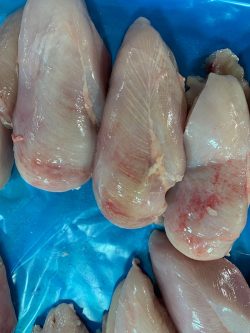
Ask the Vet: White striping
By Dr. Tom Inglis
Features Ask the VetIs white striping disease, which is very prevalent in the U.S., also of concern in Canada?
 White striping on left progressing to wooden breast on right.
White striping on left progressing to wooden breast on right. Yes, white striping is a concern in Canada and in some regions and production systems it is more prevalent. It’s important to differentiate between whether white striping is a disease or a defect because we don’t necessarily observe any symptoms or impaired function of the muscles in the live birds.
White striping is a form of myopathy or inflammation of the muscle that is primarily noted in the largest and most valuable muscle of the chicken – the pectoralis major (breast) muscle.
There is a continuum of severity of the myopathy conditions from normal breast in which we can see the white striations running parallel to the muscle fibres to the most severe forms referred to as spaghetti meat and wooden breast in which the meat has a completely abnormal appearance and is unusable in most applications.

Wooden breast with hemorrhage (this meat is hard and unusable).
When we look at thin sections of fixed muscle tissue using a microscope, the more mild or early form of these myopathies, which is white striping, shows fat accumulation between the muscle fibers (lipidosis). The most extreme or chronic forms such as spaghetti meat or wooden breast shows connective tissue replacing the lipid, which is what makes the texture change.
The exact cause of white striping and the myopathies are unknown but rapid growth rate and larger bird sizes are associated as key predisposing risk factors. Genetic, nutritional and environmental factors that contribute metabolic stress such as higher breast yield, higher latitudes, higher protein rations and higher C02 levels in the barn appear to contribute to the severity and incidence of the problem.
Because there is such a large variation in the incidence and severity of the myopathy conditions across flocks with the same region, genetics, hatchery source and nutrition programs we see the importance and impact of managing of the multifactorial risk factors.
It is an important condition to pay attention to, as it can have severe impacts on the quality and usability of the meat products. In the most severe forms, it will result in condemnation of affected carcasses and meat cuts.
From a producer perspective, all of the best management practices used to prevent ascites will have an impact on white striping and wooden breast. So, that is something that producers can do regardless of complaints from the plant or increased condemnations.
There is an excellent review article for anyone interested in learning more on the current understanding of white striping and myopathies in Poultry Science (2021 Jun3 100[6]. A critical review of the mechanisms involved in the occurrence of growth-related abnormalities affecting broiler chicken breast muscles, Soglia et al.).
The primary author of this article is Dr. Tom Inglis. The vets of Poultry Health Services are regular contributors to Ask the Vet. They offer, amongst other services, a brooding program that includes guidance around creating an optimal barn environment for your flocks. Please send questions for the Ask the Vet column to poultry@annexweb.com.
Print this page